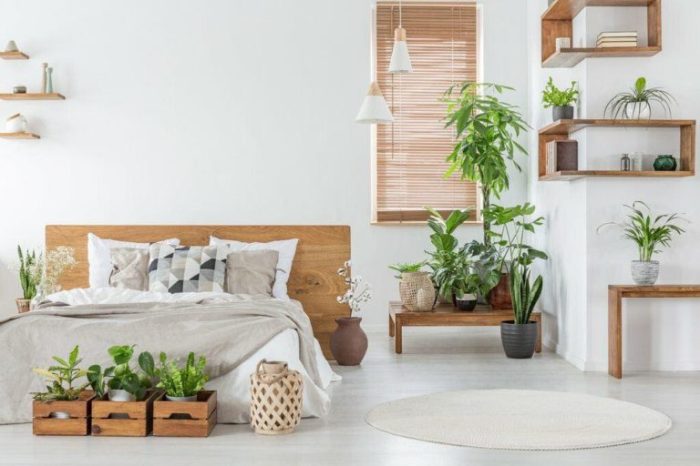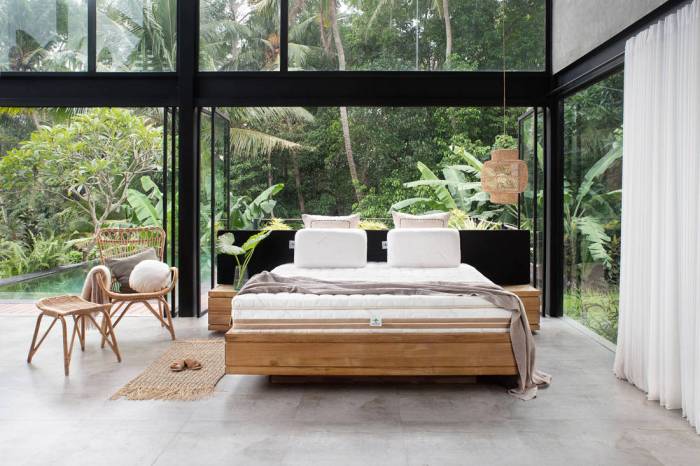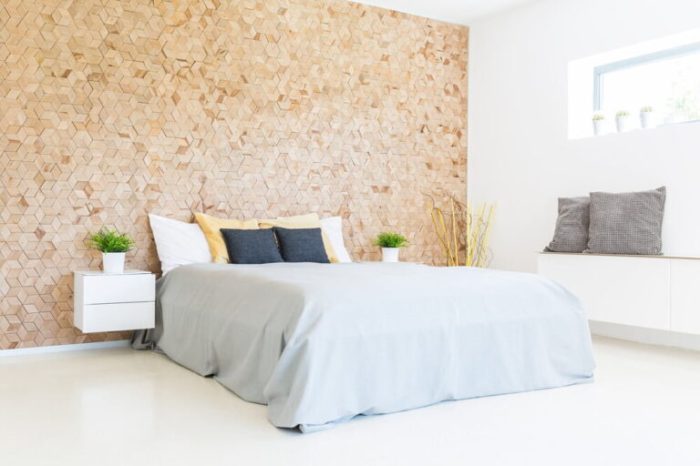Creating a sustainable and eco-friendly bedroom is not only beneficial for the environment but also for your health and well-being. By incorporating eco-friendly materials, sustainable furniture, and energy-efficient appliances, you can reduce your environmental impact while creating a comfortable and inviting space.
This comprehensive guide will provide you with everything you need to know about sustainable and eco-friendly bedroom decoration, from choosing sustainable materials to incorporating plants and greenery. Whether you’re looking to make small changes or completely overhaul your bedroom, this guide has something for everyone.
Eco-friendly Materials
Incorporating eco-friendly materials into your bedroom décor not only enhances its aesthetics but also promotes sustainability. These materials minimize environmental impact, ensuring a healthier and more responsible living space.
Synthetic materials, commonly used in conventional décor, release harmful chemicals and contribute to pollution. Eco-friendly alternatives like bamboo, organic cotton, and reclaimed wood offer durable, non-toxic, and renewable options.
Bamboo
- Sustainably harvested, bamboo replenishes itself quickly, reducing deforestation.
- Its natural antibacterial properties promote a hygienic sleep environment.
- Bamboo bedding, furniture, and flooring provide a comfortable and eco-conscious choice.
Organic Cotton
- Cultivated without pesticides or synthetic fertilizers, organic cotton protects soil health and biodiversity.
- Its soft, breathable fabric regulates temperature, ensuring a comfortable sleep.
- Organic cotton sheets, blankets, and curtains add a touch of luxury while minimizing environmental impact.
Reclaimed Wood
- By repurposing old wood, reclaimed wood reduces waste and preserves forests.
- Its unique character adds warmth and rustic charm to bedroom furniture and décor.
- Reclaimed wood headboards, nightstands, and dressers embody both style and sustainability.
Sustainable Furniture
Incorporating sustainable furniture into your bedroom decor is crucial for creating an eco-friendly space. Sustainable furniture is crafted from materials sourced responsibly, minimizing environmental impact. These materials often come from renewable or recycled sources, ensuring the longevity of natural resources.
Durability and Longevity
Eco-friendly furniture is renowned for its exceptional durability and longevity. By utilizing high-quality materials and construction techniques, these pieces withstand wear and tear, reducing the need for replacements and contributing to waste reduction. Sustainable furniture investments not only enhance your bedroom’s aesthetics but also ensure long-lasting functionality.
Environmental Impact Comparison
| Material | Environmental Impact |
|---|---|
| Solid Wood (FSC-Certified) | Renewable resource, minimal carbon footprint |
| Bamboo | Fast-growing, sustainable alternative to wood |
| Recycled Metal | Reduces landfill waste, conserves natural resources |
| Plastic (Recycled or Biodegradable) | Lowers plastic pollution, promotes circular economy |
Natural Lighting and Ventilation
Incorporating ample natural light and ventilation into your bedroom design not only enhances its aesthetics but also contributes significantly to your overall well-being.
Natural light, when optimized, can reduce the need for artificial lighting, conserving energy and creating a more serene and inviting atmosphere. Moreover, it helps regulate your body’s natural sleep-wake cycle, promoting restful sleep and improved mood.
Maximizing Natural Light
To maximize natural light, consider incorporating large windows or skylights. Windows should be strategically placed to capture the morning sun, which helps regulate your circadian rhythm and provides a natural wake-up call. Skylights, on the other hand, allow light to penetrate from above, creating a more evenly lit and spacious feel.
Ventilation
Proper ventilation ensures fresh air circulation, reducing indoor pollutants and creating a healthier sleeping environment. Incorporate cross-ventilation by installing windows on opposite walls or using fans to facilitate air movement. Ventilation also helps regulate temperature, keeping your bedroom cool and comfortable.
Energy-Efficient Appliances
Energy-efficient appliances play a crucial role in creating a sustainable and eco-friendly bedroom. These appliances not only reduce energy consumption, leading to lower utility bills, but also contribute to environmental conservation by minimizing greenhouse gas emissions.
By choosing energy-efficient lighting, fans, and other appliances, you can significantly reduce your energy consumption and environmental impact. In the long run, these investments can lead to substantial savings and a more sustainable lifestyle.
Energy-Efficient Lighting
Energy-efficient lighting options, such as LED and CFL bulbs, consume significantly less energy than traditional incandescent bulbs. LED bulbs, in particular, are known for their long lifespan and energy efficiency. By switching to energy-efficient lighting, you can reduce your lighting energy consumption by up to 80%, resulting in lower electricity bills and reduced environmental impact.
Energy-Efficient Fans
Energy-efficient fans, such as ceiling fans with DC motors, consume less energy while providing effective cooling. DC motors are more efficient than traditional AC motors, allowing fans to operate at lower speeds while maintaining adequate airflow. By using energy-efficient fans, you can reduce your energy consumption and create a more comfortable sleeping environment.
Other Energy-Efficient Appliances
Other energy-efficient appliances for the bedroom include air purifiers, humidifiers, and dehumidifiers. These appliances can help improve air quality and comfort while minimizing energy consumption. Look for appliances with Energy Star certification to ensure they meet energy efficiency standards.
Biodegradable and Compostable Textiles
Incorporating biodegradable and compostable textiles into your bedroom decor is a crucial step towards creating a sustainable and eco-friendly space. These textiles offer significant environmental benefits, minimizing the impact of your bedding, curtains, and rugs on the planet.
Synthetic textiles, commonly used in home decor, are derived from non-renewable resources like petroleum. Their production and disposal contribute to greenhouse gas emissions, water pollution, and microplastic accumulation in the environment. In contrast, biodegradable and compostable textiles are made from natural materials like organic cotton, bamboo, hemp, or linen, which break down naturally over time, reducing waste and preserving the ecosystem.
Examples of Sustainable Textile Options
- Organic Cotton: Certified organic cotton is grown without the use of synthetic pesticides or fertilizers, ensuring a sustainable cultivation process.
- Bamboo: Bamboo is a rapidly renewable resource that requires minimal water and fertilizers to grow. Its fibers are naturally antimicrobial and breathable.
- Hemp: Hemp is a durable and versatile fiber that is naturally resistant to pests and diseases, making it a low-maintenance crop.
- Linen: Linen is a biodegradable and hypoallergenic fabric made from flax fibers. It is highly absorbent and breathable, making it ideal for bedding.
Waste Reduction and Recycling
Minimizing waste and recycling play crucial roles in eco-friendly bedroom décor. Reducing waste conserves resources and limits the environmental impact of discarded materials. Recycling transforms waste into valuable resources, reducing landfill strain and promoting circularity.
Repurposing and Upcycling
Repurposing old furniture and textiles extends their lifespan, reducing waste. Consider transforming an old dresser into a nightstand or an antique headboard into a decorative wall accent. Upcycling involves creatively modifying old items into new ones, such as turning discarded textiles into throw pillows or curtains.
Local Recycling Programs
Research local recycling programs to determine accepted materials. Many communities offer curbside recycling for paper, plastic, metal, and glass. Some also accept electronics, batteries, and hazardous waste. Participating in these programs ensures proper disposal and reduces landfill waste.
Plants and Greenery
Incorporating plants into bedroom décor offers a multitude of benefits, from enhancing aesthetics to purifying the air we breathe. Certain plants possess remarkable air-purifying qualities, removing toxins and pollutants that can compromise our health.
Choosing the right plants for your bedroom is crucial. Consider plants known for their air-purifying abilities, such as peace lilies, snake plants, and spider plants. These plants effectively remove formaldehyde, benzene, and trichloroethylene from the air, creating a healthier sleeping environment.
Care and Maintenance
- Ensure adequate sunlight: Place plants near a window or use grow lights to provide the necessary light for photosynthesis.
- Water regularly: Determine the specific watering needs of each plant and adjust accordingly.
- Control humidity: Some plants, like ferns, thrive in humid environments. Consider using a humidifier or misting the plant regularly.
- Repot as needed: As plants grow, they may require a larger pot to accommodate their root systems.
Outcome Summary
Creating a sustainable and eco-friendly bedroom is an ongoing process, but it’s one that is well worth the effort. By making small changes over time, you can create a space that is both beautiful and sustainable. So what are you waiting for? Get started today and make your bedroom a haven of sustainability and comfort.



